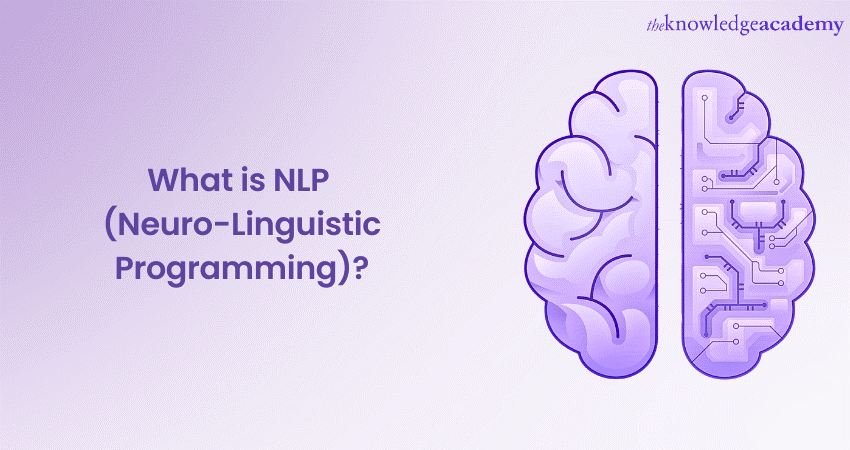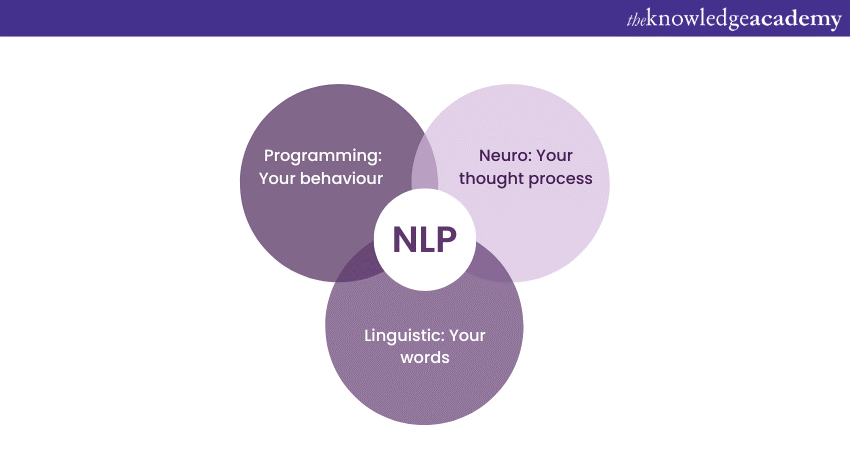We may not have the course you’re looking for. If you enquire or give us a call on 01344203999 and speak to our training experts, we may still be able to help with your training requirements.
Training Outcomes Within Your Budget!
We ensure quality, budget-alignment, and timely delivery by our expert instructors.

Neuro-Linguistic Programming (NLP) is referred to as the study of human behaviour and excellence. It is well known for improving the life quality of people, allowing them to live a happier and more fulfilling life. But What Is NLP exactly? Neuro-Linguistic Programming is a practice that combines the knowledge of neurology, linguistics, and human behavioural patterns. Read this blog to learn more!
Table of Contents
1) Understanding NLP in detail
2) How does NLP work?
3) NLP techniques
4) Examples of NLP
5) Does NLP really work?
6) Conclusion
Understanding NLP in detail
NLP is a psychological approach that explores the connection between neurological processes, language, and patterns of behaviours. Its goal is to enhance personal development and communication skills. NLP focuses on understanding what factors lead to a person's actions, thus helping people with personal development. This is done by understanding how a person’s brain forms an internal map to filter perceived information.
Origins
The term NLP was coined by John Grinder, a Linguist and Richard Bandler, a Mathematician, in 1975 in their book “The Structure of Magic 1”. The book stated the connection between three key elements responsible for a person’s behavioural pattern and the results they produce. These key elements were as follows:

Neuro: The term "Neuro" in NLP was derived from “Neurological processes”, meaning the mental process of filtering information. As per NLP, a person has a mental map which consists of internal images, sensations, spatial and tactile awareness and olfactory senses. A person’s first mental map is called “First access” in Neuro-Linguistic Programming, a product of your neurological filtering process.
Linguistic: Linguistic refers to NLP’s use of language as a medium which carries messages or information to you. According to NLP, a person’s brain can assign messages to information it receives from outside. These messages can exist in the form of images, feelings, smells and tastes.
Think of how a certain time on the watch can make you hungry, as your brain has registered that particular time as dinner time. Alternatively, certain smells might make you feel relaxed due to the memory you have assigned to that smell in the past. Your brain can create a second map based upon these personalised messages created, referred to as “Linguistic R epresentation”.
Programming: "Programming" in NLP refers to behavioural patterns people acquire over time. According to Grinder and Bandler, these patterns can be taught to others by studying these behavioural patterns in geniuses and successful individuals can be taught to others. It was theorised that replicating these patterns in others would result in similar outcomes, allowing these individuals to be extremely successful.
Evolution
NLP has evolved and grown as a concept and applied method over time. Its evolution and development took place over different periods as follows:
1970: NLP’s development occurred during different periods, beginning in 1970 when Neuro-Linguistic Programming was first inspired. Grinder and Bandler discovered its foundational principles, drawing inspiration from therapists such as Milton Erickson and Virginia Satir and utilising the Milton Model in the early stages of NLP's development.
1980: Grinder and Bandler released books that raised the popularity of NLP among people. One such book was “Frogs into Princes”, which introduced the concepts of NLP practices for personal development and therapy. As a result, many other practitioners developed their interpretation of NLP, creating new branches in the practice.
Some new branches in Neuro-Linguistic Programming included Systematic NLP and Sleight of Mouth Patterns created by Robert Dilts. Some other branches included New Code NLP, NLP Modelling and Advanced Submodalities Work by Grinder and Bandler.
1990: NLP found new uses and applications beyond therapy, and some such uses included sports, education and businesses. Using NLP techniques allowed many people to succeed personally and professionally and improve their communication skills.
2000: Different psychological approaches for personal and professional development were integrated with NLP. Some popular approaches like Cognitive Behaviour Therapy (CBT) and Positive Psychology got integrated with NLP.
2010: Researchers and Neuroscientists gained interest in Neuro-Linguistic Programming, trying to validate its claim and benefits. The rise in technology in this era only boosted the popularity of this practice further. The increased internet use led to NLP becoming more well-known due to higher global visibility, thus gaining a wider range of audience.
Present: As NLP became more popular, it was subjected to criticism, as its critics demanded validation of its claims and practices. As a result, over the years, the focus has shifted to delivering evidential results from Neuro-Linguistic Programming. This has allowed the practice to evolve further, growing and getting refined even as you read this blog.
Learn the details of the human thought process with our NLP Training!
How does NLP work?
The fundamental idea of Neuro-Linguistic Programming is that if an individual understands how another person completes a task, the process can be shared with others to yield better results. The successful way to complete a task can thus be copied and communicated to improve efficiency. This is used in various fields like sports, arts, law, medicine, business, education, etc.
It is believed by the proponents of NLP that every individual draws a personal mind map before approaching any task. Those having an idea of NLP create an overview of that task in mind and analyse different perspectives to get it done. These perspectives help gain a detailed understanding of information which is helpful while performing a task.
NLP Practitioners believe that there are six logical levels of change, namely:
a) Purpose and spirituality: This is considered to be the highest level of change. It can involve something larger than life such as religion or morals.
b) Identity: Identity is how you see yourself. Your identity includes the understanding of your roles and responsibilities in life.
c) Beliefs and values: These are matters of your personal beliefs and causes that matter to you.
d) Capabilities and skills: It Is the reflection of your abilities and knowing what you can do.
e) Behaviour: It represents the character and actions you showcase.
f) Environment: It is considered to be the lowest level of change. It includes your surroundings, or the people around you. In simple terms, it is the context in which change is happening.
Discover the three main learning styles of NLP with our Neuro Linguistic Programming Course!
NLP techniques
NLP is a vast area of practice, and it involves various techniques that help understand human behaviour and achieve personal or professional development. Some of the popular NLP techniques are discussed below.
Rapport
It is a technique used to build connection between individuals. It represents a sense of closeness, mutual understanding or trust that people feel while communicating. The NLP Practitioner uses this empathy to improve the communication and responses of the person.
Visual, Auditory, and Kinesthetic (VAK) Systems
This technique works by identifying a person’s preferred sensory system. It helps make communication between the NLP Practitioner and person easy. The main purpose of VAK System is to eliminate the negative thoughts or feelings, or memories of a past event.
Swish Pattern
This technique replaces the negative behaviour or thoughts of a person with positive ones. It completely changes the way one thinks, feels and acts. It is a visualisation technique that helps a person to respond better to certain trigger points.
Anchoring
It is a technique that helps you connect to a specific emotion through a sensory feeling like a touch, word or a gesture. It helps a person to control their emotional state and personal experiences responsibly. The whole aim of Anchoring is to establish a connection between an action or experience and a particular emotion or state, so that you can easily recall that emotion whenever you wish to.
Timeline Therapy
Timeline Therapy helps to let go of any negative emotions such as fear, agony, anxiety etc., by removing these emotions from the memory of a person. It helps them act freely without worrying about the emotional trauma of the past.
Examples of NLP
NLP has been used extensively in various fields for various purposes. Discussed below are three of the most popular areas where NLP is implemented:
a) NLP is used to develop the personality of an individual by improving their confidence, self- reflection and communication.
b) In the domain of business, it has been used to carry out work-related tasks, like increasing a person’s productivity or helping a person advance in career.
c) NLP is also being used as a form of therapy for various mental health issues such as depression, anxiety disorders, post-traumatic stress disorder, etc.

Does NLP really work?
It is extremely difficult to determine the effectiveness of NLP as a practice due to its lack of formal regulations. Scientific research on Neuro-Linguistic Programming often has mixed results, making it extremely tough to gauge its effectiveness.
Ethical criticism of NLP
As NLP grew in popularity over many decades, it also received its fair share of criticism. One of its many ethical criticisms was the lack of a governing body. This raised the potential of people misusing the techniques or even using them with incomplete knowledge, leading to great harm. Like most psychological techniques, NLP has the potential to be abused for personal gains and the emotional manipulations.
Scientific Criticisms of NLP
NLP was also criticised strongly due to insufficient scientific evidence, especially in its earlier development stages. It gathered the interest of counseling research during the early 80s and was considered a vital advancement in psychotherapy and counselling. However, the interest in Neuro-Linguistic Programming started fading over time due to the extensive scientific research on the subject.
Thanks to the internet, NLP gained its newfound popularity, and it also gathered the interest of researchers. This provided the practice with a second chance at gathering scientific evidence of its validity. While the results for Neuro-Linguistic Programming had mixed results, they were not negative; thus, the individual claims of people benefitting from it remain undisputed.
Conclusion
As we conclude this blog, we hope you understood the principles and application of Neuro-Linguistic Programming. This blog covered subjects like What is NLP, its principles and how valid the practice is in the modern era. There is no doubt that the practice is surrounded by criticism due to a lack of scientific evidence; however, the benefits it has brought to people over time cannot be denied. Thank you for reading!
Try our NLP Foundation and Practitioner Training course to persuade others with your words!
Frequently Asked Questions
Upcoming Business Skills Resources Batches & Dates
Date
 Neuro Linguistic Programming
Neuro Linguistic Programming
Fri 24th May 2024
Fri 12th Jul 2024
Fri 13th Sep 2024
Fri 22nd Nov 2024







 Top Rated Course
Top Rated Course


 If you wish to make any changes to your course, please
If you wish to make any changes to your course, please


